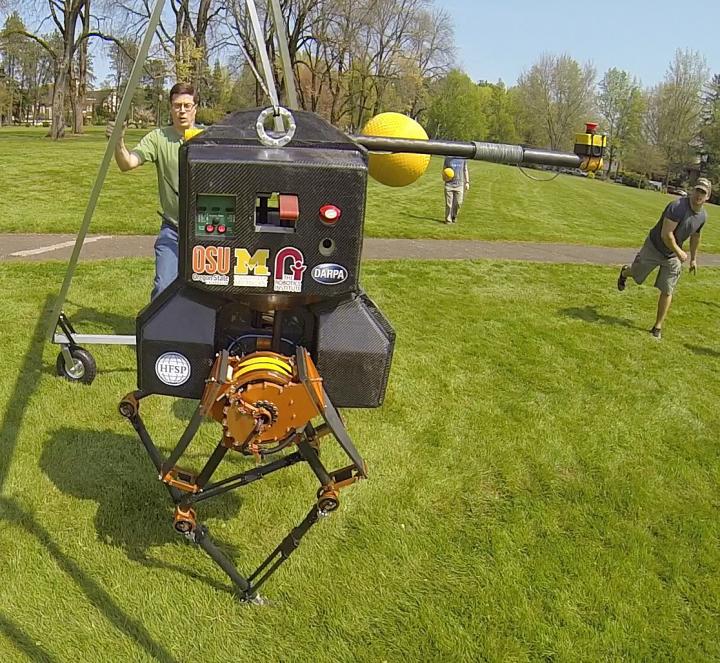'Spring-mass' technology heralds the future of walking robots

Engineers at Oregon State University have successfully field tested their walking robot, ATRIAS. (Photo courtesy of Oregon State University)
The system is based on a concept called “spring-mass” walking that was theorized less than a decade ago, and combines passive dynamics of a mechanical system with computer control. It provides the ability to blindly react to rough terrain, maintain balance, retain an efficiency of motion and essentially walk like humans do.
As such, this approach to robots that can walk and run like humans opens the door to entire new industries, jobs and mechanized systems that do not today exist.
The findings on spring-mass walking have been reported for the first time in IEEE Transactions on Robotics, by engineers from OSU and Germany. The work has been supported by the National Science Foundation, the Defense Advanced Research Projects Agency and the Human Frontier Science Program.
The technologies developed at OSU have evolved from intense studies of both human and animal walking and running, to learn how animals achieve a fluidity of motion with a high degree of energy efficiency. Animals combine a sensory input from nerves, vision, muscles and tendons to create locomotion that researchers have now translated into a working robotic system.
The system is also efficient. Studies done with their ATRIAS robot model, which incorporates the spring-mass theory, showed that it's three times more energy-efficient than any other human-sized bipedal robots.
“I'm confident that this is the future of legged robotic locomotion,” said Jonathan Hurst, an OSU professor of mechanical engineering and director of the Dynamic Robotics Laboratory in the OSU College of Engineering.
“We've basically demonstrated the fundamental science of how humans walk,” he said.
“Other robotic approaches may have legs and motion, but don't really capture the underlying physics,” he said. “We're convinced this is the approach on which the most successful legged robots will work. It retains the substance and science of legged animal locomotion, and animals demonstrate performance that far exceeds any other approach we've seen. This is the way to go.”
The current technology, Hurst said, is still a crude illustration of what the future may hold. When further refined and perfected, walking and running robots may work in the armed forces. As fire fighters they may charge upstairs in burning buildings to save lives. They could play new roles in factories or do ordinary household chores.
Aspects of the locomotion technology may also assist people with disabilities, the researchers said.
“Robots are already used for gait training, and we see the first commercial exoskeletons on the market,” said Daniel Renjewski, the lead author on the study with the Technische Universitat Munchen. “However, only now do we have an idea how human-like walking works in a robot. This enables us to build an entirely new class of wearable robots and prostheses that could allow the user to regain a natural walking gait.”
There are few limits to this technology, the researchers said.
“It will be some time, but we think legged robots will enable integration of robots into our daily lives,” Hurst said. “We know it is possible, based on the example of animals. So it's inevitable that we will solve the problem with robots. This could become as big as the automotive industry.”
And much of this, the scientists said, will be based on the “spring-mass” concept, which animals have been perfecting through millions of years of evolution.
The robots being constructed at OSU were designed to mimic this “spring-legged” action of bipedal animals. With minor variations, muscles, tendons and bones form a structure that exhibits most of the required behavior, and conscious control just nudges things a little to keep it going in the right direction. The effort is smooth and elastic, and once understood, can be simulated in walking robots by springs and other technology.
ATRIAS, the human-sized robot most recently created at OSU, has six electric motors powered by a lithium polymer battery about the size of a half-gallon of milk, which is substantially smaller than the power packs of some other mobile robots. It can take impacts and retain its balance. It can walk over rough and bumpy terrain.
Researchers said in their new study that this technology “has the potential to enhance legged robots to ultimately match the efficiency, agility and robustness of animals over a wide variety of terrain.”
In continued research, work will be done to improve steering, efficiency, leg configuration, inertial actuation, robust operation, external sensing, transmissions and actuators, and other technologies.
###
Other collaborators in the development of this technology have included Jessy Grizzle at the University of Michigan and Hartmut Geyer at Carnegie Mellon University. Scientific work on the motion of animals was done with Monica Daley at the Royal Veterinary College, which guided the robot's development.
Editor's Note: Video is available with this story: http://bit.
Media Contact
All latest news from the category: Information Technology
Here you can find a summary of innovations in the fields of information and data processing and up-to-date developments on IT equipment and hardware.
This area covers topics such as IT services, IT architectures, IT management and telecommunications.
Newest articles

First-of-its-kind study uses remote sensing to monitor plastic debris in rivers and lakes
Remote sensing creates a cost-effective solution to monitoring plastic pollution. A first-of-its-kind study from researchers at the University of Minnesota Twin Cities shows how remote sensing can help monitor and…

Laser-based artificial neuron mimics nerve cell functions at lightning speed
With a processing speed a billion times faster than nature, chip-based laser neuron could help advance AI tasks such as pattern recognition and sequence prediction. Researchers have developed a laser-based…

Optimising the processing of plastic waste
Just one look in the yellow bin reveals a colourful jumble of different types of plastic. However, the purer and more uniform plastic waste is, the easier it is to…



